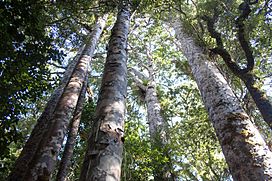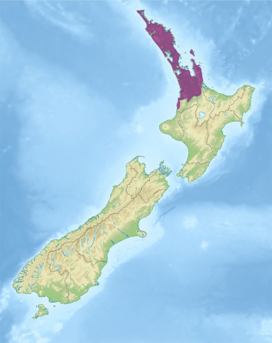Northland temperate kauri forests facts for kids
Quick facts for kids Northland temperate kauri forests |
|
|---|---|

Kauri trees (Agathis australis) in Waipoua Forest
|
|

Ecoregion territory (in purple)
|
|
| Ecology | |
| Realm | Australasian |
| Biome | temperate broadleaf and mixed forests |
| Borders | Northland temperate forests |
| Geography | |
| Area | 28,786 km2 (11,114 sq mi) |
| Country | New Zealand |
| Regions | Auckland, Northland and Waikato |
| Conservation | |
| Protected | 3,555 km² (12%) |
The Northland temperate kauri forests is a special natural area, or ecoregion, found in the northern part of New Zealand. It's part of a bigger group of forests called temperate broadleaf and mixed forests. This means it has trees that often have broad leaves and grow in places with mild temperatures. This ecoregion is famous for its giant kauri trees.
Contents
Exploring the Northland Kauri Forests
This ecoregion covers the northern tip of North Island in New Zealand. The land here is quite flat compared to other parts of the country. It includes the areas of Northland, Auckland (around the city of Auckland), and Waikato (near the town of Hamilton).
Kauri trees naturally grow north of 38°S latitude. The region also has several islands off the coast. You can find some of New Zealand's last original wetland areas here. These include the Firth of Thames, the Kopuatai Peat Dome, and the Whangamarino Wetland. The weather in this ecoregion is generally warm and humid.
Amazing Plants of the Kauri Forests
This area is home to many unique plants that grow nowhere else. These are called endemic plants. Places like Cape Reinga and Te Paki in Northland have many of them. These areas were sometimes cut off from the rest of the island by high sea levels in the past.
The ecoregion gets its name from its most famous plant, the incredible southern kauri tree. These trees are truly huge! They can grow up to 55 meters (180 feet) tall and 20 meters (65 feet) around. A kauri tree often has a long, straight trunk up to 30 meters (98 feet) high with no lower branches. Its crown, or top part, spreads out wide.
Not many areas are still covered thickly by the kauri forest that once grew everywhere here. However, the kauri trees are so massive that they stand out even when there are only a few. Much of the kauri forest was cut down for its valuable wood. The land was then used for farming. This region is the southernmost place where kauri trees grow. You can also find mangrove trees here.
The offshore islands, like the Poor Knights Islands and Three Kings Islands, have even more endemic species. These include rare plants such as the only species of Elingamita. Other special plants found there are Pennantia baylisiana and Three Kings vine.
Unique Animals of the Kauri Forests
The forests are home to several rare birds. These include the endangered North Island kokako wattlebird and the North Island brown kiwi. There are also three types of parrots found only in New Zealand: the red-crowned parakeet, the New Zealand kaka, and the kakapo. The kakapo is a very rare flightless parrot. It now only lives on the offshore Little Barrier Island.
You can also find interesting invertebrates in the region. These include the large wētā and cave wētā.
Protecting the Kauri Forests
This rich and fertile area has been the most populated part of New Zealand for a long time. Because of this, most of the original kauri forest was removed. People used to cut down the trees for timber and collect gum from them.
Luckily, logging and gum-tapping have stopped now. Much of the remaining kauri forest is now protected. These protected areas are found in the Northland region and on the Coromandel Peninsula. The largest groups of kauri trees are in Waipoua Forest. Another big area is Trounson Kauri Park, south of Aranga. Both of these important places are on the west coast of Northland.
The wildlife in this region faces dangers from animals that were brought to New Zealand by people. These are called introduced predators. They include the Polynesian rat, ferrets, and stoats. These predators harm native plants and animals. Because of this, the strongest groups of many plants, birds, and reptiles are now found on offshore islands. These islands are safer than North Island itself.
Some species from North Island have been moved to these offshore islands to help protect them. Other species found on the islands are native to those small islands. This includes several types of lizards on the Mercury Islands and the Falla's skink on the Three Kings Islands.
See also
 In Spanish: Bosques templados de kauri de las Northlands para niños
In Spanish: Bosques templados de kauri de las Northlands para niños

